Senna Leaf
| Home | | Pharmacognosy |Chapter: Pharmacognosy and Phytochemistry : Drugs Containing Glycosides
Senna leaf consists of the dried leaflets of Cassia acutifolia Delile (C. senna L.) known as Alexandrian senna and of C. angustifolia Vahl., which is commercially known as Tin-nevelly senna. It belong family Leguminosae.
SENNA LEAF
Synonyms
Alexandrian senna, Tinnevelly senna, Folia senna.
Biological Source
Senna leaf consists of the dried leaflets of Cassia acutifolia Delile (C. senna L.) known as Alexandrian senna
and of C. angustifolia Vahl., which
is commercially known as Tin-nevelly senna. It belong family Leguminosae.
Geographical Source
Alexandrian senna is indigenous to South Africa. It widely
grows and sometimes is cultivated in Egypt and in the middle upper territories
of Nile river. It is also cultivated in Kordofan and Sennar regions of Sudan.
Indian or Tinnevelly senna is indigenous to southern Arabia and cultivated
largely in Tinnevelly and Ramnathpuram districts of Tamilnadu. It also grows in
Somaliland, Sindh and Punjab region.
Cultivation and Collection
Senna plant is a small shrub of 1–1.5 m height with
paripinnate compound leaves. Tinnevelly senna is mostly cultivated in
well-ploughed, levelled, rich clayed semiirrigated land sometimes after paddy
crop in South India. Propagation is done by seeds which are rubbed with coarse
sand and sown thinly by broadcasting or in rows 30 cm apart, first during
February–March and second after rain in July. Seeds germinate on the third day.
The crop becomes ready for harvesting after about 2 months but first plucking
of leaflets is done after 3 months of sowing when the leaves appears mature,
thick and bluish in colour. Second plucking is fol-lowed after a month and
subsequent pluckings after 4–6 weeks. The plant can survive for two to three years,
but it is grown as an annual. After third plucking the plants are uprooted.
Plant shows great tolerance for salinity. It some-times shows die-back symptoms
in which the branches or shoots die from the tip inward, which is caused by
parasites or environmental conditions. Leaflets of Tinnevelly senna are
collected by careful plucking from luxuriantly grown plants and compressed into
bales.
Alexandrian senna is obtained almost entirely from the wild
and sometimes from the cultivated plants. At the stage of fully formed fruits,
branches are cut off and rapidly dried in the sun. Pods and large stalks are
first separated by using sieves. Leaves separated from stalks are graded into
whole leaves, whole and half leaves and shiftings. Whole leaves and shiftings are
generally used for making galenical preparations. The leaves are packed loosely
in bales for marketing.
Characteristics
Senna leaflets are 3–5 cm long, 2 cm wide and about 0.5 mm
thick. It shows acute apex, entire margin and asymmetric base. Outline is
lanceolate to ovate lanceolate. Pubescent lamina is found on both the surfaces.
Leaves show greyish green colour for Alexandrian senna and yellowish green for
Tinnevelly senna. Leaves of Tinnevelly senna are somewhat larger, less broken
and firmer in texture than that of Alexandrian senna. Odour of leaves is
slight but characteristic and the taste is bitter, mucilagenous. Both the types
of leaflets show impression or transverse markings due to the pressing of
midrib. Distingushing characters of Alexandrian and Indian senna are given in
Table below.
Table : Distinguishing characters of Alexandrian and Indian senna
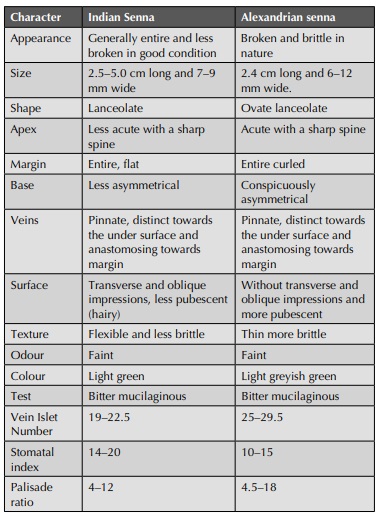
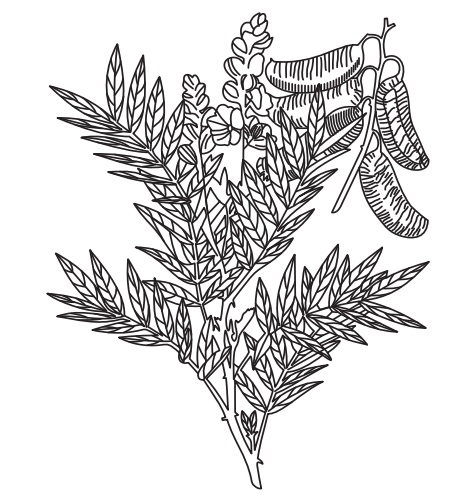
Microscopy
Being isobilateral leaf, senna shows more or less similar
features at both the surfaces of leaf with few differences. Transverse section
of leaf shows upper and lower epidermis with straight wall cells, few of which
contain mucilage. Paracytic stomata and nonlignified unicellular trichomes are
found on both the surfaces. A single layer of palisade parenchyma is observed
at both the sides but it is discontinued in the midrib region of lower
epidermis due to the zone of collenchymatous tissues. Palisade is followed by
spongy mesophyll which contains cluster crystals of calcium oxalate and
vascular strands. Midrib shows the vascular bundle containing xylem and phloem,
almost surrounded by lignified pericyclic fibres and a sheath of parenchyma
which contains prismatic crystals of calcium oxalate.
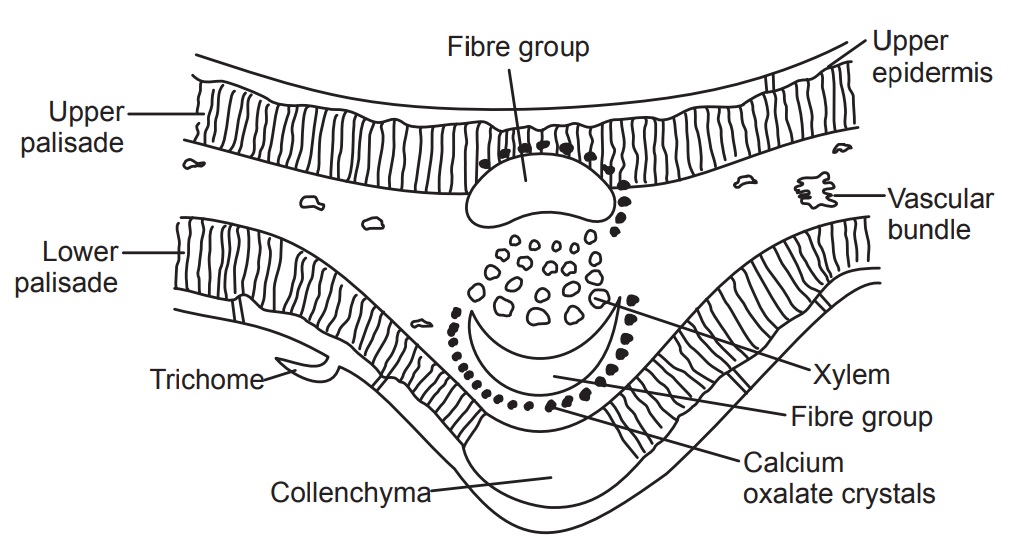
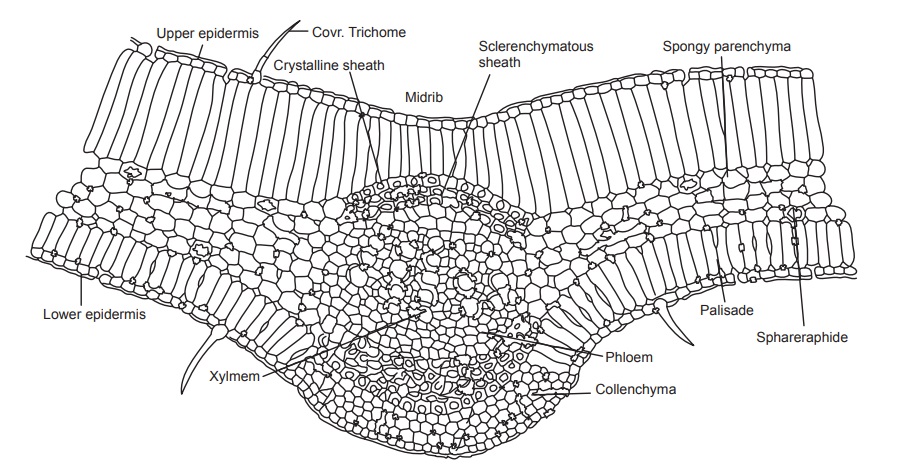
Transverse section of senna leaflet
Chemical Constituents
Senna contains sennosides A and B (2.5%) based on the
aglycones sennidin A and B, sennosides C and D which are glycosides of
heterodianthrones of aloe-emodin and rhein are present. Others include palmidin
A, rhein anthrone and aloe-emodin glycosides. Senna also contains free chryso
phanol, emodin and their glycosides and free aloe-emodin, rhein, their
monoanthrones, dianthrones and their glycosides. Mucilage is present in the
epidermis of the leaf and gives red colour with ruthenium red.
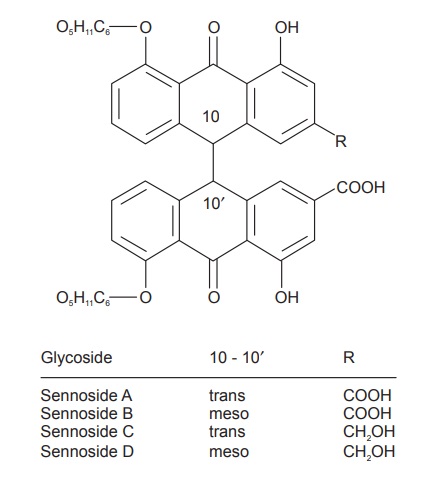
Chemical Test
Borntrager test for anthraquinones: The leaves are boiled with dilute sulphuric acid and
filtered. To the filtrate organic solvent like benzene, ether or chloroform is
added and shaken. The organic layer is separated, and to it add ammonia
solution. The ammoniacal layer produces pink to red colour indicating the
presence of anthraquinone glycoside.
Uses
Senna leaves are used as laxative. It causes irritation of
large intestine and have some griping effect. Thus they are prescribed along
with carminatives. Senna is stimulant cathartic and exerts its action by
increasing the tone of the smooth muscles in large intestine.
Adulterants
Cassia obovata (Dog Senna): They occur as small
pieces with Alexandrian senna but can
be easily identified by its obovata shape and obtuse and tapering apex. It has
only 1% anthraquinone derivatives. The presence of Cassia auriculata (Palthe senna) can be identified by treating it
with 80% sulphuric acid. It gives red colour.
Cassia angustifolia (Bombay or Mecca or Arabian senna) a mild variety of Indian senna have the
morphology similar to that of Tinnevelly senna but the leaflets are narrow,
more elongated and brownish green in colour. C. marilandica or American Senna, Wild Senna, Poinciana pulcherima, formerly Maryland
Senna, is a common perennial from New England to Northern Carolina. Its
leaves are compressed into oblong cakes like other herbal preparations of the
Shakers. It acts like Senna, but is weaker, and should be combined with
aromatics. These leaves are also found mixed with or substituted for
Alexandrian Senna. Coriaria myrtifolia is a Mediterranean shrub and
highly poisonous, so that it should be
recognized when present. The leaves are green, very thin and soft, three
veined, ovatelanceolate, and equal at the base. It is also used to adulterate
sweet marjoram. Cassia montana yields
a false Senna from Madras, partly resembling the Tinnevelly Senna, though the
colour of the upper surface of the leaves is browner.
Marketed Products
It is one of the ingredients of the preparations known as
Constivac, Softovac (Lupin Herbal Laboratory) and Isova powder, Kultab tablet
(Vasu Healthcare).
